Purpleback Flying Squid Sthenoteuthis oualaniensis in the South China Sea: Growth, Resources and Association with the Environment
Abstract
1. Introduction
2. Materials and Methods
2.1. Catch Data
2.2. Environmental Remote Sensing Data
2.3. Biological Data
2.4. Methods
3. Results
3.1. Temporal and Spatial Changes in Environmental Conditions
3.2. Growth Status of S. oualaniensis in the South China Sea
3.3. Temporal and Spatial Changes in CPUE
3.4. GAMs Analysis
3.5. Relationship between CPUE and Environment
4. Discussion
4.1. S. Oualaniensis Population Structure
4.2. Analysis of Growth Status of S. oualaniensis
4.3. Relationship between CPUE and Environment
5. Conclusions
Author Contributions
Funding
Institutional Review Board Statement
Data Availability Statement
Conflicts of Interest
References
- Rodhouse, G.P. World squid resources; Review of the State of World Marine Fisheries. FAO Fish. Tech. Pap. 2005, 457, 175–187. [Google Scholar]
- Jereb, P.; Roper, C.F.E. Cephalopods of the world. An annotated and illustrated catalogue of cephalopod species known to date. Volume 2. Myopsid and oegopsid squids. FAO Species Cat. Fish. Purp. 2010, 2, 315–318. [Google Scholar]
- FAO. FAO Yearbook. Fishery and Aquaculture Statistics 2018; Food and Agriculture Organization of the United Nations: Rome, Italy, 2020; p. 11. [Google Scholar] [CrossRef]
- Arkhipkin, A.I.; Rodhouse, P.G.K.; Pierce, G.J.; Sauer, W.; Sakai, M.; Allcock, L.; Arguelles, J.; Bower, J.R.; Castillo, G.; Ceriola, L.; et al. World squid fisheries. Rev. Fish. Sci. Aquac. 2015, 23, 92–252. [Google Scholar] [CrossRef]
- Chesalin, M.V. Distribution and biology of the squid Sthenoteuthis oualaniensis in the Arabian Sea. Hydrobiol. J. 1994, 30, 61–73. [Google Scholar]
- Chen, X.J.; Lu, H.J.; Liu, B.L.; Chen, Y.; Li, S.L.; Ma, J. Species identification of Ommastrephes bartramii, Dosidicus gigas, Sthenoteuthis oualaniensis and Illex argentinus (Ommastrephidae) using beak morphological variables. Sci. Mar. 2012, 76, 473–481. [Google Scholar] [CrossRef]
- Norman, M.D.; Nabhitabhata, J.; Lu, C.C. An updated checklist of the cephalopods of the South China Sea. Raffles Bull. Zool. 2016, 34, 566–592. [Google Scholar]
- Zhang, Y. Fisheries Acoustic Studies on the Purpleback Flying Squid Resource in the South China Sea. Master’s Thesis, Institute of Oceanography, National Taiwan University, Taipei, Taiwan, 2005. [Google Scholar]
- Feng, B.; Yan, Y.R.; Zhang, Y.M.; Yi, M.R.; Lu, H.S. A new method to assess the population of Sthenoteuthis oualaniensis in South China Sea. Prog. Fish. Sci. 2014, 35, 1–6. (In Chinese) [Google Scholar] [CrossRef]
- Stuart, V.; Platt, T.; Sathyendranath, S. The future of fisheries science in management: A remote-sensing perspective. ICES J. Mar. Sci. 2011, 68, 644–650. [Google Scholar] [CrossRef]
- Bacha, M.; Jeyid, M.A.; Vantrepotte, V.; Dessailly, D.; Amara, R. Environmental effects on the spatio-temporal patterns of abundance and distribution of Sardina pilchardus and sardinella off the Mauritanian coast (North-West Africa). Fish. Oceanogr. 2017, 26, 282–298. [Google Scholar] [CrossRef]
- Rodhouse, P.G. Managing and forecasting squid fisheries in variable environments. Fish. Res. 2001, 54, 3–8. [Google Scholar] [CrossRef]
- Robinson, C.J.; Gómez-Gutiérrez, J.; de León, D.A.S. Jumbo squid (Dosidicus gigas) landings in the Gulf of California related to remotely sensed SST and concentrations of chlorophyll a (1998–2012). Fish. Res. 2013, 137, 97–103. [Google Scholar] [CrossRef]
- Liu, S.G.; Liu, Y.; Fu, C.H.; Yan, L.X.; Tian, Y.J. Using novel spawning ground indices to analyze the effects of climate change on Pacific saury abundance. J. Mar. Syst. 2018, 191, 13–23. [Google Scholar] [CrossRef]
- Chassot, E.; Bonhommeau, S.; Reygondeau, G.; Nieto, K.; Polovina, J.J.; Huret, M.; Dulvy, N.K.; Demarcq, H. Satellite remote sensing for an ecosystem approach to fisheries management. ICES J. Mar. Sci. 2011, 68, 651–666. [Google Scholar] [CrossRef]
- Stretta, J.M. Forecasting models for tuna fishery with aerospatial remote sensing. Int. J. Remote Sens. 1991, 12, 771–779. [Google Scholar] [CrossRef]
- Yu, J.; Hu, Q.W.; Tang, D.L.; Chen, P.M. Environmental effects on the spatiotemporal variability of purpleback flying squid in Xisha-Zhongsha waters, South China Sea. Mar. Ecol. Prog. Ser. 2019, 623, 25–37. [Google Scholar] [CrossRef]
- Chan, B.; Brosse, S.; Hogan, Z.S.; Peng, B.N.; Lek, S. Influence of local habitat and climatic factors on the distribution of fish species in the Tonle Sap Lake. Water 2020, 12, 786. [Google Scholar] [CrossRef]
- Yu, J.; Hu, Q.W.; Tang, D.L.; Zhao, H.; Chen, P.M. Response of Sthenoteuthis oualaniensis to marine environmental changes in the north-central South China Sea based on satellite and in situ observations. PLoS ONE 2019, 14, e211474. [Google Scholar] [CrossRef]
- Chen, X.J.; Tian, S.Q.; Chen, Y.; Liu, B. A modeling approach to identify optimal habitat and suitable fishing grounds for neon flying squid in the Northwest Pacific Ocean. Fish. Bull. Natl. Ocean. Atmos. Adm. 2010, 108, 1–14. [Google Scholar]
- Mugo, R.; Saitoh, S.; Nihira, A.; Kuriyama, T. Habitat characteristics of skipjack tuna (Katsuwonus pelamis) in the western North Pacific: A remote sensing perspective. Fish. Oceanogr. 2010, 19, 382–396. [Google Scholar] [CrossRef]
- Hsieh, C.H.; Glaser, S.M.; Lucas, A.J.; Sugihara, G. Distinguishing random environmental fluctuations from ecological catastrophes for the North Pacific Ocean. Nature 2005, 435, 336–340. [Google Scholar] [CrossRef]
- Drexler, M.; Ainsworth, C.H. Generalized additive models used to predict species abundance in the Gulf of Mexico: An ecosystem modeling tool. PLoS ONE 2013, 8, e64458. [Google Scholar] [CrossRef] [PubMed]
- Agenbag, J.J.; Richardson, A.J.; Demarcq, H.; Fréon, P.; Weeks, S.; Shillington, F.A. Estimating environmental preferences of South African pelagic fish species using catch size- and remote sensing data. Prog. Oceanogr. 2003, 59, 275–300. [Google Scholar] [CrossRef]
- Tseng, C.T.; Su, N.J.; Sun, C.L.; Punt, A.E.; Yeh, S.Z.; Liu, D.C.; Su, W.C. Spatial and temporal variability of the Pacific saury (Cololabis saira) distribution in the northwestern Pacific Ocean. ICES J. Mar. Sci. 2013, 70, 991–999. [Google Scholar] [CrossRef]
- Feng, Y.J.; Chen, X.J.; Liu, Y. Examining spatiotemporal distribution and CPUE environment relationships for the jumbo flying squid Dosidicus gigas off shore Peru based on spatial autoregressive model. Chin. J. Oceanol. Limnol. 2018. [Google Scholar] [CrossRef]
- Mohamed, K.S.; Sajikumar, K.K.; Ragesh, N.; Ambrose, T.V.; Jayasankar, J.; Said Koya, K.P.; Sasikumar, G. Relating abundance of purpleback flying squid Sthenoteuthis oualaniensis (Cephalopoda: Ommastrephidae) to environmental parameters using GIS and GAM in south-eastern Arabian Sea. J. Nat. Hist. 2018, 52, 1869–1882. [Google Scholar] [CrossRef]
- Bigelow, K.A. Age and Growth of Three Species of Squid Paralarvae from Hawaiian Waters as Determined by Statolith Microstructures. Ph.D. Thesis, USA University of Hawaii, Honolulu, HI, USA, 1991. [Google Scholar]
- Liu, B.L. Studying Age and Growth of Purple Back Flying Squid (Sthenoteuthis oualaniensis) in Northwest Indian Ocean Based on Statolith Microstructure. Master’s Thesis, Shanghai Ocean University, Shanghai, China, 2006. (In Chinese). [Google Scholar]
- Santos, M.N.; Gaspar, M.B.; Vasconcelos, P.; Monterio, C.C. Weight-length relationships for 50 selected fish species of the Algarve coast (southern Portugal). Fish. Res. 2002, 59, 289–295. [Google Scholar] [CrossRef]
- Wang, X.H.; Qiu, Y.S.; Du, F.Y.; Lin, Z.J.; Sun, D.R.; Huang, S.L. Population parameters and dynamic pool models of commercial fishes in the Beibu Gulf, northern South China Sea. Chin. J. Oceanol. Limnol. 2012, 30, 105–117. [Google Scholar] [CrossRef]
- Akaike, H. Likelihood of a model and information criteria. J. Econom. 1981, 16, 3–14. [Google Scholar] [CrossRef]
- Chen, X.J.; Lu, H.J.; Liu, B.L.; Chen, Y. Age, growth and population structure of jumbo flying squid, Dosidicus gigas, based on statolith microstructure off the Exclusive Economic Zone of Chilean waters. J. Mar. Biol. Assoc. UK 2011, 91, 229–235. [Google Scholar] [CrossRef]
- Hastie, T.J.; Tibshirani, R.J. Generalized additive models. Stat. Sci. 1986, 1, 297–310. [Google Scholar] [CrossRef]
- Wood, S.N. Stable and efficient multiple smoothing parameter estimation for generalized additive models. J. Am. Stat. Assoc. 2004, 99, 673–686. [Google Scholar] [CrossRef]
- Wood, S.N. Fast stable restricted maximum likelihood and marginal likelihood estimation of semiparametric generalized linear models. J. R. Stat. Soc. B 2011, 73, 3–36. [Google Scholar] [CrossRef]
- Liu, B.L.; Chen, X.J.; Li, J.H.; Chen, Y. Age, growth and maturation of Sthenoteuthis oualaniensis in the eastern tropical Pacific Ocean by statolith analysis. Mar. Freshw. Res. 2015, 67, 1973. [Google Scholar] [CrossRef]
- Chen, X.J.; Liu, B.L.; Tian, S.Q.; Qian, W.G.; Zhao, X.H. Fishery biology of purpleback squid, Sthenoteuthis oualaniensis, in the northwest Indian Ocean. Fish. Res. 2007, 83, 98–104. [Google Scholar] [CrossRef]
- Chembian, A.J.; Mathew, S. Population structure of the purpleback squid Sthenoteuthis oualaniensis (Lesson, 1830) along the south-west coast of India. Indian J. Fish. 2014, 61, 20–28. [Google Scholar]
- Liu, H.J.; Tong, Y.H.; Liu, W.; Liu, K.; Dong, Z.X.; Chen, X.; Chen, X.J. Fisheries biological characteristics of Sthenoteuthis oualaniensis in the spring season in the El Nino year of 2016 in the Zhongsha Islands waters of South China Sea. J. Fish. China 2018, 42, 912–921. (In Chinese) [Google Scholar] [CrossRef]
- Li, J.H.; Chen, X.J.; Fang, Z.; Liu, B.L.; Gao, C.X. Comparison of fishery biology of Sthenoteuthis oualaniensis in three fishing areas. Mar. Fish. 2016, 38, 561–569. (In Chinese) [Google Scholar] [CrossRef]
- Shen, C.Y.; Zhao, H.; Chen, F.J.; Xiao, H.W. The distribution of aerosols and their impacts on chlorophyll-a distribution in the South China Sea. J. Geophys. Res. Biogeosciences 2020, 125. [Google Scholar] [CrossRef]
- Merten, V.; Christiansen, B.; Javidpour, J.; Piatkowski, U.; Puebla, O.; Gasca, R.; Hoving, H.T.; Thuesen, E.V. Diet and stable isotope analyses reveal the feeding ecology of the orangeback squid Sthenoteuthis pteropus (Steenstrup 1855) (Mollusca, Ommastrephidae) in the eastern tropical Atlantic. PLoS ONE 2017, 12, e189691. [Google Scholar] [CrossRef]
- Shchetinnikov, A.S. Feeding spectrum of squid Sthenoteuthis oualaniensis (Oegopsida) in the eastern Pacific. J. Mar. Biol. Assoc. UK 1992, 72, 849–860. [Google Scholar] [CrossRef]
- Macarthur, R.H.; Pianka, E.R. On optimal use of a patchy environment. Am. Nat. 1966, 100, 603–609. [Google Scholar] [CrossRef]
- Froese, R.; Thorson, J.T.; Reyes, R.B. A Bayesian approach for estimating length-weight relationships in fishes. J. Appl. Ichthyol. 2014, 30, 78–85. [Google Scholar] [CrossRef]
- Daban, I.B.; Ismen, A.; Ihsanoglu, M.A.; Cabbar, K. Age, growth and reproductive biology of the saddled seabream (Oblada melanura) in the North Aegean Sea, Eastern Mediterranean. Oceanol. Hydrobiol. Stud. 2020, 49, 13–22. [Google Scholar] [CrossRef]
- Thomas, J.; Venu, S.; Kurup, B.M. Length-weight relationship of some deep-sea fish inhabiting the continental slope beyond 250 m depth along the West Coast of India. NAGA World Fish Cent. Q. 2003, 26, 17–21. [Google Scholar]
- Wang, X.H.; Qiu, Y.S.; Zhang, P.; Du, F.Y. Natural mortality estimation and rational exploitation of purpleback flying squid Sthenoteuthis oualaniensis in the southern South China Sea. Chin. J. Oceanol. Limnol. 2017, 35, 902–911. [Google Scholar] [CrossRef]
- Chen, G.B.; Zhang, J.; Yu, J.; Fan, J.T.; Fang, L.C. Hydroacoustic scattering characteristics and biomass assessment of the purpleback flying squid [Sthenoteuthis oualaniensis, (Lesson, 1830)] from the deepwater area of the South China Sea. J. Appl. Ichthyol. 2013, 29, 1447–1452. [Google Scholar] [CrossRef]
- Zakaria, M.Z.B. Age and growth studies of oceanic squid, Sthenoteuthis oualaniensis using statoliths in the South China Sea, Area III, western Philippines. In Proceedings of the SEAFDEC Seminar on Fishery Resources in the South China Sea, Area III: Western Philippines, Bangkok, Thailand, 13–15 July 1999; Southeast Asian Fisheries Development Center: Bangkok, Thailand, 2000; pp. 118–134. [Google Scholar]
- Liu, B.L.; Chen, X.J.; Zhong, J.S. Age, growth and population structure of squid Sthenoteuthis oualaniensis in north west Indian Ocean by statolith microstructure. J. Dalian Ocean Univ. 2009, 24, 206–212. (In Chinese) [Google Scholar] [CrossRef]
- Arkhipkin, A.I. Diversity in growth and longevity in short-lived animals: Squid of the suborder Oegopsina. Mar. Freshw. Res. 2004, 55, 341–355. [Google Scholar] [CrossRef]
- Liu, B.L.; Lin, J.Y.; Feng, C.L.; Li, C.L.; Su, H. Estimation of age, growth and maturation of purpleback flying squid, Sthenoteuthis oualaniensis, in Bashi Channel, central Pacific Ocean. J. Ocean Univ. China 2017, 16, 525–531. [Google Scholar] [CrossRef]
- Takagi, K.; Kitahara, T.; Suzuki, N.; Mori, J.; Yatsu, A. The age and growth of Sthenoteuthis oualaniensis (Cephaloopoda: Ommastrephidae) in the Pacific Ocean. Bull. Mar. Sci. 2002, 71, 1105–1108. [Google Scholar]
- Sukramongkol, N.; Promjinda, S.; Prommas, R. Age and reproduction of Sthenoteuthis oualaniensis in the Bay of Bengal. In The Ecosystem-Based Fishery Management in the Bay of Bengal; Department of Fisheries (DOF), Ministry of Agriculture and Cooperatives: Bangkok, Thailand, 2007; pp. 195–205. [Google Scholar]
- Nguyen, H.M.; Rountrey, A.N.; Meeuwig, J.J.; Coulson, P.G.; Meekan, M.G. Growth of a deep-water, predatory fish is influenced by the productivity of a boundary current system. Sci. Rep. 2015, 5, 9044. [Google Scholar] [CrossRef] [PubMed]
- Zhang, Y.M.; Yan, Y.R.; Lu, H.S.; Zheng, Z.W.; Yi, M.R. Study on feeding and reproduction biology of purple flying squid, Sthenoteuthis oualaniensis in the Western South China Sea. J. Guangdong Ocean Univ. 2013, 33, 56–64. (In Chinese) [Google Scholar] [CrossRef]
- Paulino, C.; Segura, M.; Chacón, G. Spatial variability of jumbo flying squid (Dosidicus gigas) fishery related to remotely sensed SST and chlorophyll-a concentration (2004–2012). Fish. Res. 2016, 173, 122–127. [Google Scholar] [CrossRef]
- Doty, M.S.; Oguri, M. The island mass effect. ICES J. Mar. Sci. 1956, 22, 33–37. [Google Scholar] [CrossRef]
- Mohamed, K.S.; Sasikumar, G.; Said Koya, K.P.; Venketesan, V.; Kripa, V.; Durgekar, R.; Joseph, M.; Alloycious, P.S.; Mani, R.; Vijai, D. Know… The Master of the Arabian Sea Purple-Back Flying Squid Sthenoteuthis oualaniensis; Central Marine Fisheries Research Institute: Kocchi, India, 2011. [Google Scholar]
- Ichii, T.; Mahapatra, K.; Sakai, M.; Wakabayashi, T.; Okamura, H.; Igarashi, H.; Inagake, D.; Okada, Y. Changes in abundance of the neon flying squid Ommastrephes bartramii in relation to climate change in the central North Pacific Ocean. Mar. Ecol. Prog. Ser. 2011, 441, 151–164. [Google Scholar] [CrossRef]
- Alabia, I.D.; Saitoh, S.; Igarashi, H.; Ishikawa, Y.; Usui, N.; Kamachi, M.; Awaji, T.; Seito, M. Future projected impacts of ocean warming to potential squid habitat in western and central North Pacific. ICES J. Mar. Sci. 2016, 73, 1343–1356. [Google Scholar] [CrossRef]
- Ichii, T.; Mahapatra, K.; Sakai, M.; Okada, Y. Life history of the neon flying squid: Effect of the oceanographic regime in the North Pacific Ocean. Mar. Ecol. Prog. Ser. 2009, 378, 1–11. [Google Scholar] [CrossRef]
- Vijai, D.; Sakai, M.; Kamei, Y.; Sakurai, Y. Spawning pattern of the neon flying squid Ommastrephes bartramii (Cephalopoda: Oegopsida) around the Hawaiian Islands. Sci. Mar. 2014, 78, 511–519. [Google Scholar] [CrossRef]
- Stewar, J.S.; Field, J.C.; Markaida, U.; Gilly, W.F. Behavioral ecology of jumbo squid (Dosidicus gigas) in relation to oxygen minimum zones. Deep Sea Res. Part II 2013, 95, 197–208. [Google Scholar] [CrossRef]
- Stewart, J.S.; Hazen, E.L.; Bograd, S.J.; Byrnes, J.E.K.; Foley, D.G.; Gilly, W.F.; Robison, B.H.; Field, J.C. Combined climate- and prey-mediated range expansion of Humboldt squid (Dosidicus gigas), a large marine predator in the California Current System. Glob. Chang. Biol. 2014, 20, 1832–1843. [Google Scholar] [CrossRef]
- Zhou, W.F.; Xu, H.Y.; Li, A.Z.; Cui, X.S.; Chen, G.B. Comparison of habitat suitability index models for purpleback flying squid (Sthenoteuthis oualaniensis) in the open South China sea. Appl. Ecol. Env. Res. 2019, 17, 4903–4913. [Google Scholar] [CrossRef]
- Chen, X.J.; Liu, B.L.; Chen, Y. A review of the development of Chinese distant-water squid jigging fisheries. Fish. Res. 2008, 89, 211–221. [Google Scholar] [CrossRef]
- Siriraksophon, S.; Nakamura, Y.; Pradit, S.; Sukramongkol, N. Ecological aspects of oceanic squid, Sthenoteuthis oualaniensis (Lesson) in the South China Sea, area III: Western Philippines. In Proceedings of the Third Technical Seminar on Marine Fishery Resources Survey in the South China Sea, Area III: Western Philippines, Bangkok, Thailand, 13–15 July 1999; Southeast Asian Fisheries Development Center: Bangkok, Thailand, 2000; pp. 101–117. [Google Scholar]
- Bakun, A. Fronts and eddies as key structures in the habitat of marine fish larvae: Opportunity, adaptive response and competitive advantage. Sci. Mar. 2006, 70, 105–122. [Google Scholar] [CrossRef]
- Zuyev, G.; Nigmatullin, C.; Chesalin, M.; Nesis, K. Main results of long-term worldwide studies on tropical nektonic oceanic squid genus Sthenoteuthis: An overview of the Soviet investigations. Bull. Mar. Sci. 2002, 71, 1019–1060. [Google Scholar]
- O’Dor, R.K. How squid swim and fly. Can. J. Zool. 2013, 91, 413–419. [Google Scholar] [CrossRef]
- Wang, J.J.; Tang, D.L. Phytoplankton patchiness during spring intermonsoon in western coast of South China Sea. Deep Sea Res. Part II 2014, 101, 120–128. [Google Scholar] [CrossRef]
- Nishikawa, H.; Igarashi, H.; Ishikawa, Y.; Sakai, M.; Kato, Y.; Ebina, M.; Usui, N.; Masafumi, K.; Tosh, A. Impact of paralarvae and juveniles feeding environment on the neon flying squid (Ommastrephes bartramii) winter–spring cohort stock. Fish. Oceanogr. 2014, 23, 289–303. [Google Scholar] [CrossRef]
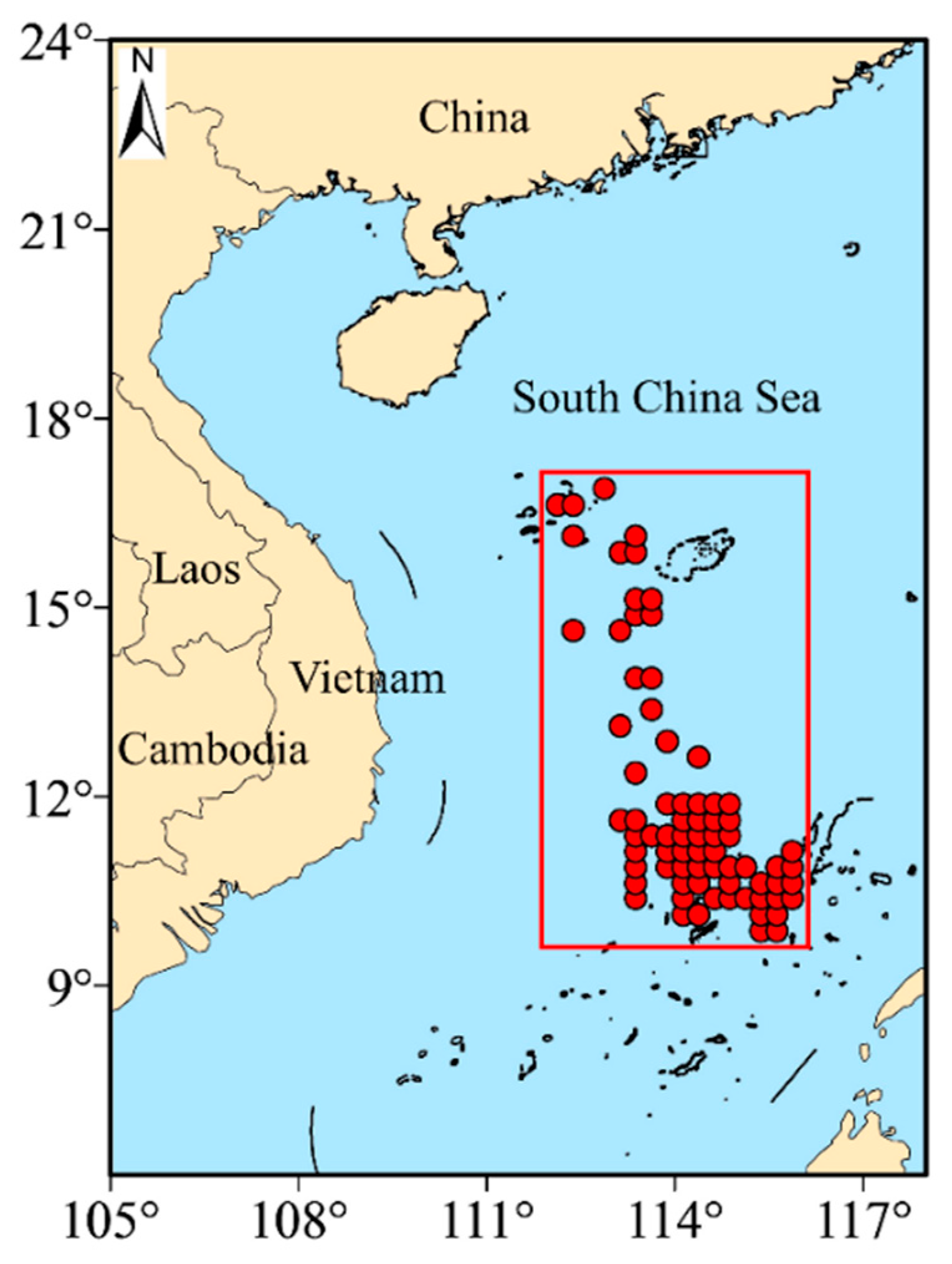
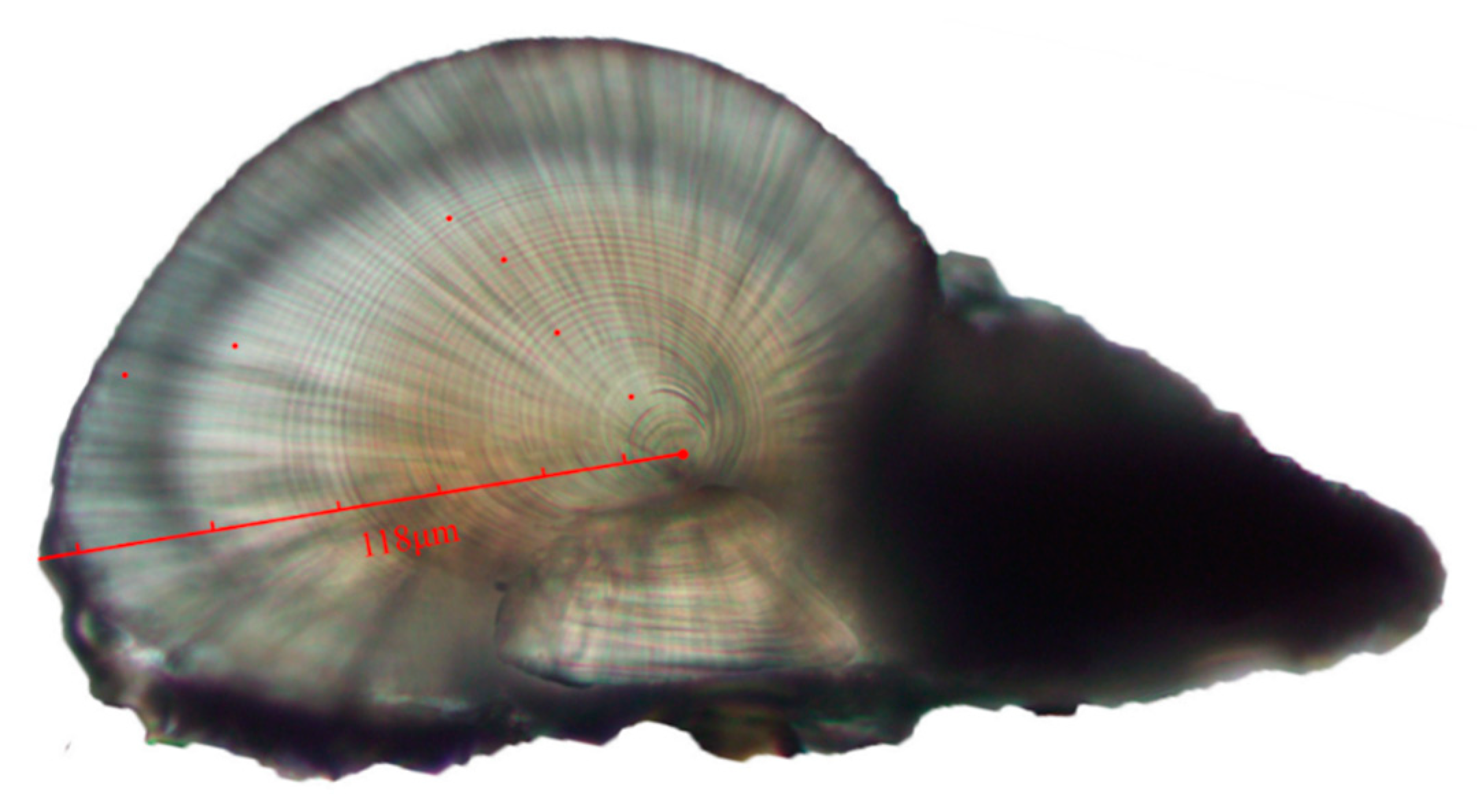
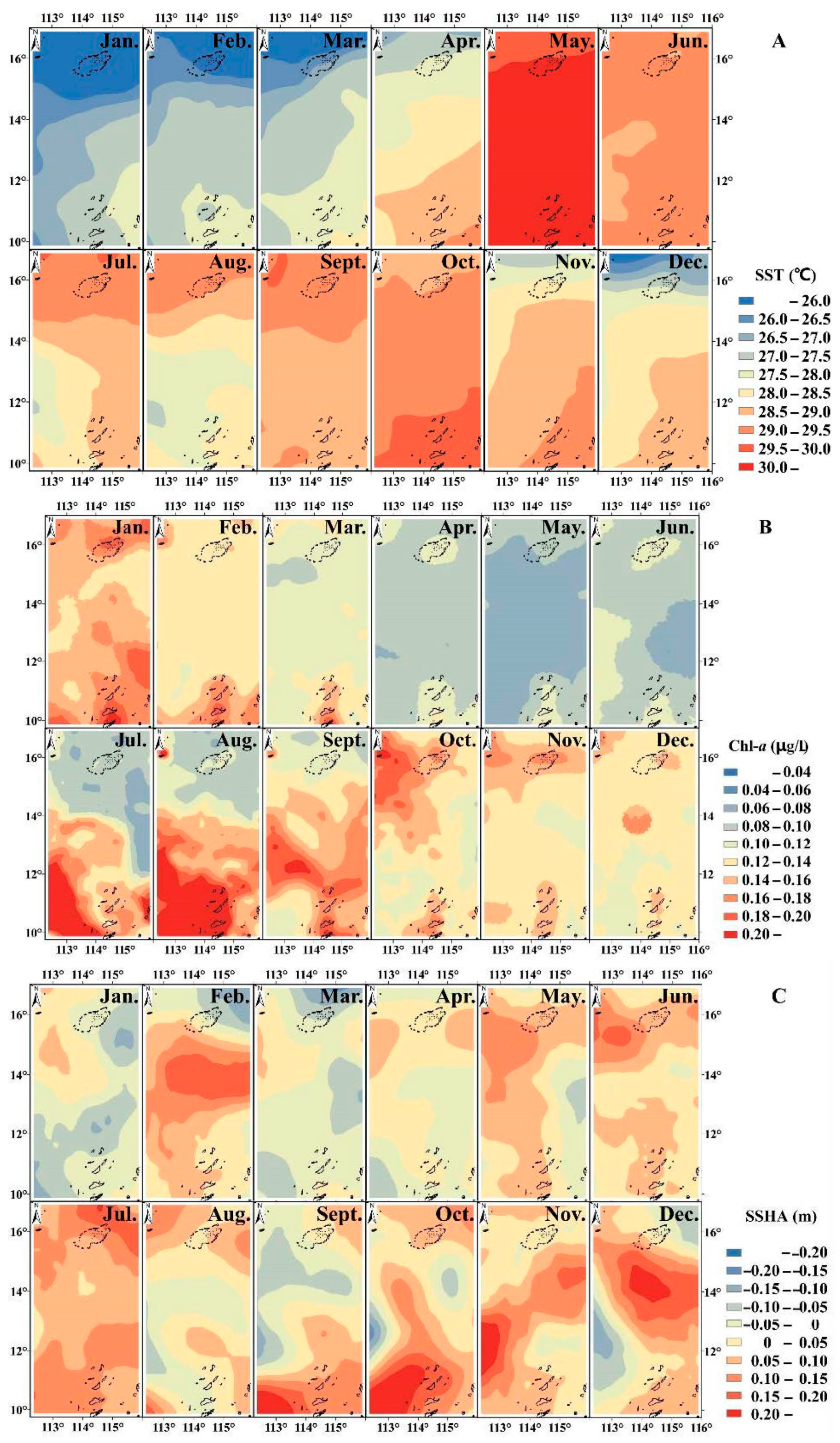
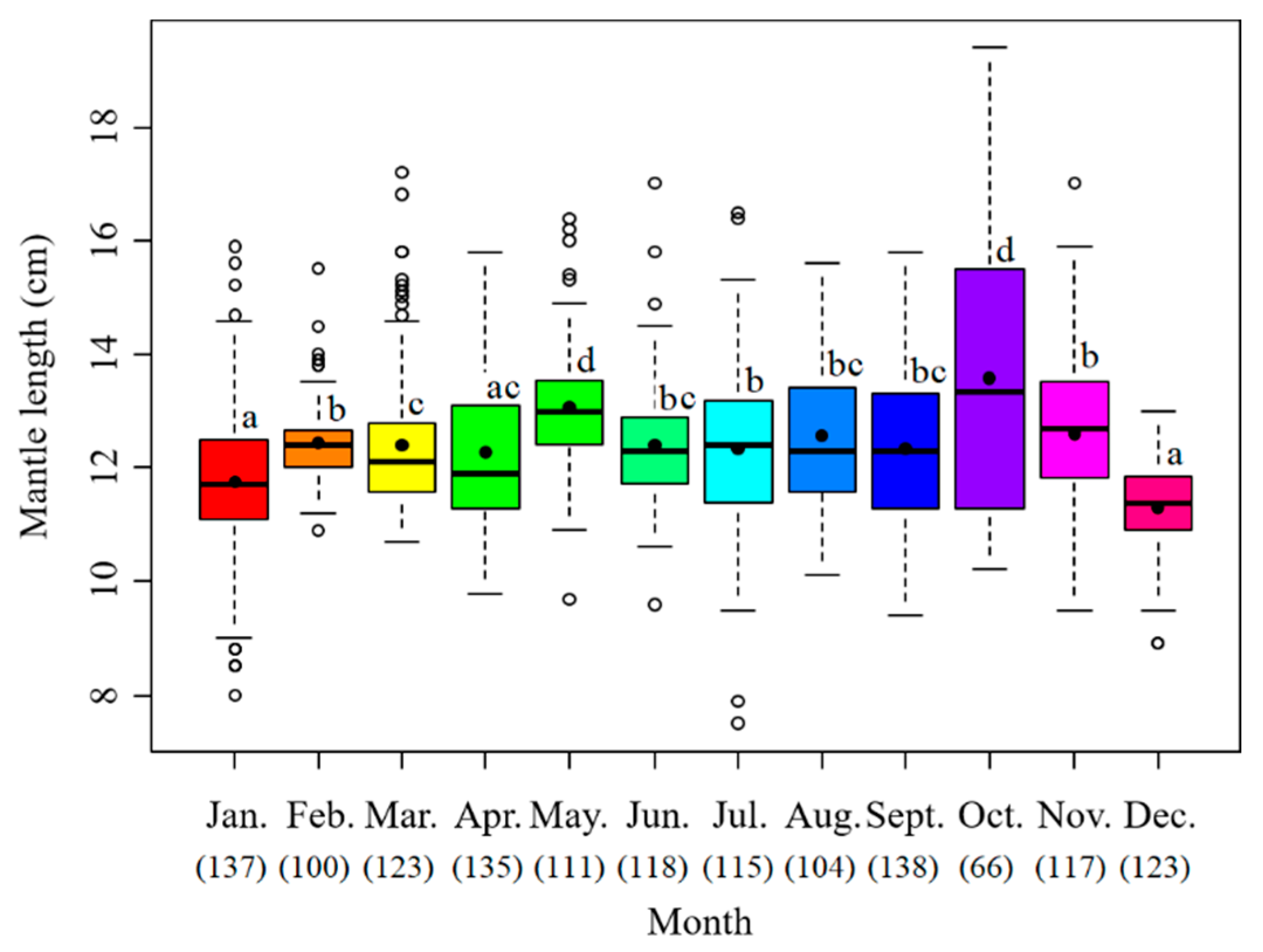

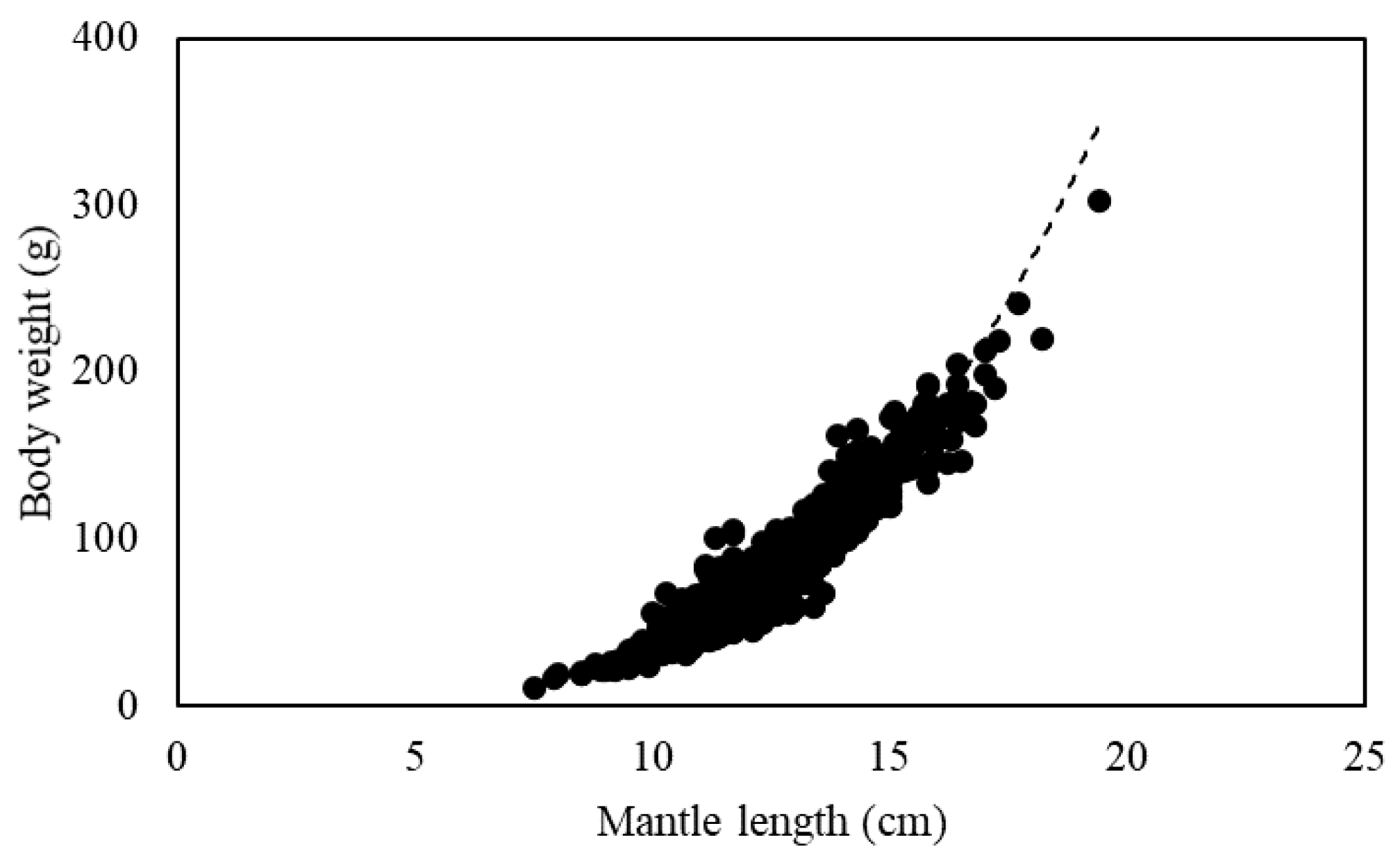
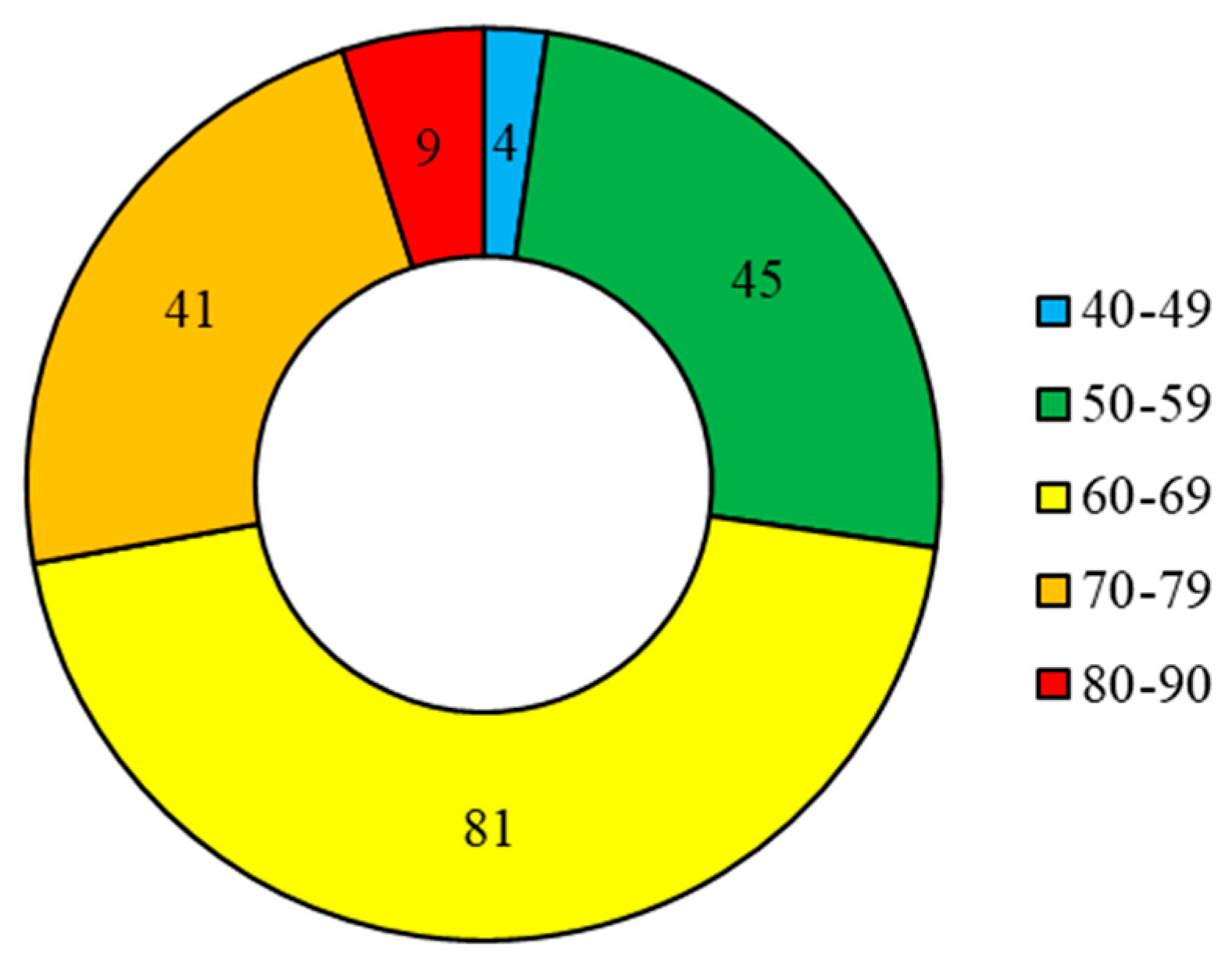
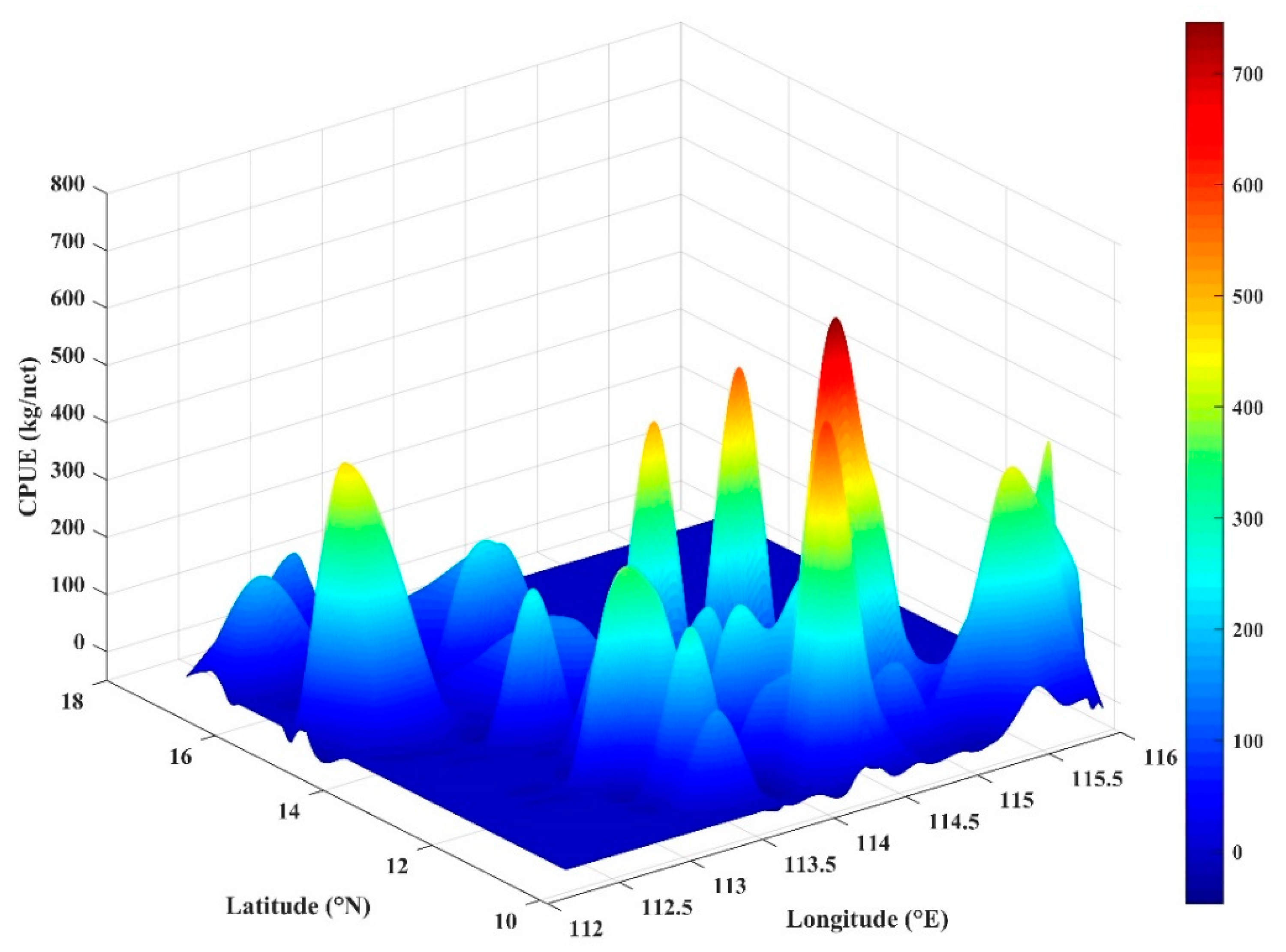


| Month | Latitude (°N) | Longitude (°E) | Station | Fishing Times |
|---|---|---|---|---|
| January | 10.625–16.875 | 112.875–115.125 | 16 | 81 |
| February | 10.125–11.625 | 112.125–114.625 | 9 | 141 |
| March | 9.875–11.625 | 113.125–115.875 | 21 | 227 |
| April | 10.125–11.375 | 113.875–115.875 | 16 | 300 |
| May | 10.375–11.625 | 114.625–115.875 | 5 | 66 |
| June | 10.375–11.125 | 114.125–115.875 | 11 | 62 |
| July | 10.375–11.875 | 114.375–115.625 | 5 | 41 |
| August | 10.125–11.625 | 114.125–114.875 | 6 | 132 |
| September | 10.125–11.625 | 114.125–115.375 | 7 | 57 |
| October | 9.875–16.875 | 112.375–115.625 | 21 | 103 |
| November | 10.375–16.125 | 113.375–115.625 | 13 | 134 |
| December | 10.375–13.875 | 113.375–114.625 | 9 | 102 |
| Total | 9.875–16.875 | 112.375–115.875 | 139 | 1446 |
| Equation | a | b | t0 | K | L∞ | AIC |
|---|---|---|---|---|---|---|
| Linear | 0 | 1.847 | - | - | - | 1202.278 |
| Exponential | 40.781 | 0.016 | - | - | - | 1205.921 |
| Power | 1.19 | 1.105 | - | - | - | 1200.628 |
| Logarithmic | 28.666 | 0 | - | - | - | 1312.476 |
| Logistic | - | - | 51.31 | 0.055 | 178.431 | 1199.549 |
| Gompertz | - | - | 44.534 | 0.037 | 194.924 | 1199.847 |
| Von Bertalanffy | - | - | 24.487 | 0.018 | 238.457 | 1200.241 |
| Model | Adjusted R2 | AIC | GCV | Variance Explained (%) |
|---|---|---|---|---|
| Model 1 | 0.286 | 373.2 | 0.849 | 32.9 |
| Model 2 | 0.369 | 359.5 | 0.774 | 42.5 |
| Model 3 | 0.436 | 350.8 | 0.739 | 51.9 |
| Model 4 | 0.489 | 338.6 | 0.68 | 57.2 |
| Model 5 | 0.542 | 326 | 0.627 | 62.6 |
Publisher’s Note: MDPI stays neutral with regard to jurisdictional claims in published maps and institutional affiliations. |
© 2020 by the authors. Licensee MDPI, Basel, Switzerland. This article is an open access article distributed under the terms and conditions of the Creative Commons Attribution (CC BY) license (http://creativecommons.org/licenses/by/4.0/).
Share and Cite
Zhao, C.; Shen, C.; Bakun, A.; Yan, Y.; Kang, B. Purpleback Flying Squid Sthenoteuthis oualaniensis in the South China Sea: Growth, Resources and Association with the Environment. Water 2021, 13, 65. https://doi.org/10.3390/w13010065
Zhao C, Shen C, Bakun A, Yan Y, Kang B. Purpleback Flying Squid Sthenoteuthis oualaniensis in the South China Sea: Growth, Resources and Association with the Environment. Water. 2021; 13(1):65. https://doi.org/10.3390/w13010065
Chicago/Turabian StyleZhao, Chunxu, Chunyan Shen, Andrew Bakun, Yunrong Yan, and Bin Kang. 2021. "Purpleback Flying Squid Sthenoteuthis oualaniensis in the South China Sea: Growth, Resources and Association with the Environment" Water 13, no. 1: 65. https://doi.org/10.3390/w13010065
APA StyleZhao, C., Shen, C., Bakun, A., Yan, Y., & Kang, B. (2021). Purpleback Flying Squid Sthenoteuthis oualaniensis in the South China Sea: Growth, Resources and Association with the Environment. Water, 13(1), 65. https://doi.org/10.3390/w13010065






